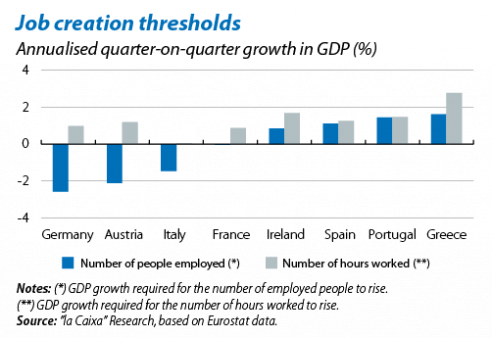Job creation will come at differing speeds
The euro area's GDP once again posted a positive growth rate in 2013 Q2 (0.3% quarter-on-quarter), after six consecutive quarters of contraction. Improvement was widespread: Germany and France led the recovery (0.7% and 0.5% quarter-on-quarter, respectively), while in the periphery the recession continues to diminish. The trend in the latest economic indicators points to this growth rate gaining ground over the coming quarters. The question now is: when will jobs start to be created?
Traditionally, a change in trend in the labour market does not usually come until medium-term growth prospects have recovered. That is why, for the moment, the recent progress made in the euro area's economic activity is only now starting to have a slight effect on the labour market. Jobs are still being lost but at a slower rate. Specifically, the quarter-on-quarter fall in employment decreased by 0.3 percentage points in 2013 Q2 to –0.1%.
One relatively simple way of determining somewhat more accurately the point as from which jobs might start to be created consists of analysing the historical relationship between the change in GDP and that of employment.(1) In general, the larger the growth in GDP, the higher the growth rate in jobs, and vice versa. But
the minimum rate of GDP growth as from which jobs
are usually created, known as the job creation
threshold (JCT), has historically been very different between countries.
On the one hand, countries such as Germany and Austria have a negative JCT. In other words, these economies do not necessarily lose jobs when they have a moderately negative GDP rate. A good example of this has occurred over the last few years: while GDP has fallen more or less sharply in these countries, the jobs lost have been almost zero in all cases. The flexibility of their labour markets has allowed them to minimise the impact of the recession
on employment. In these countries, companies were able to reduce the hours worked by their employees when facing weaker demand, thereby avoiding job losses. If, instead of analysing the relationship between GDP trends and the number of employed, we carry out the analysis using the number of hours worked, then the result is different: a positive GDP growth rate is required for the number of hours worked to grow.
On the other hand, periphery countries have a positive JCT: they usually generate employment when they have positive GDP growth rates. Specifically, it can be observed that the annualised quarter-on-quarter growth rate as from which jobs have been created is 0.8%
in Ireland, 1.1% in Spain, 1.4% in Portugal and 1.6% in Greece.(2) In these countries, whose labour markets
have historically been less flexible, the number of hours worked could not be adjusted and, therefore, the GDP growth rate required to generate employment and the one for the number of hours worked to rise are, in general, more similar.
These values are indicative of the growth rate as from which, historically, jobs have been created in net terms but the far-reaching changes being carried out by the periphery countries invites us to view such figures with caution. The gains in competitiveness achieved over the last few years by the labour factor will probably lower their JCT. A more flexible labour market in countries such as Spain and Portugal is also likely to boost the recovery in employment. Lastly, changes in the productive model occurring in many periphery countries, in general those with a more important export sector, could also modify their JCT, although in this case the final effect is difficult to generalise as it depends on the type of sector leading this process.
In short, job creation in the euro area appears to be
close at hand. The core countries, where the recovery
is expected to gain ground over the coming quarters, should consolidate the good performance being enjoyed by their labour markets. In the periphery countries, where job creation is more crucial, growth rates of around 1% are expected for the coming year, a level close to their historical JCT. This will therefore be a good test to see whether the reforms undertaken in the last few years are starting to bear fruit.
(1) See «Informe de evaluación del impacto de la reforma laboral» by the Spanish Ministry of Employment and Social Security (2013) and De Cea, P. and Dolado, J.J., «Output Growth Thresholds for Job Creation and Unemployment Reduction in Spain» (2013).
(2) These coefficients have been obtained after estimating the following regression with quarterly figures between 2000 Q1 and 2013 Q2 for each country:
rlogEmploymentt = c + a1 rlogPIBt + a2 rlogPIBt-1.
